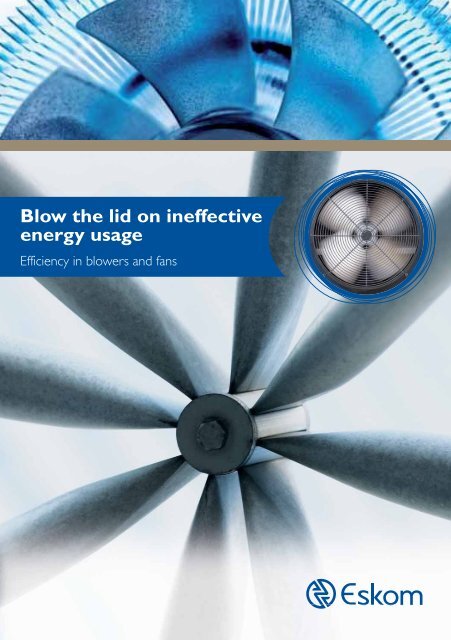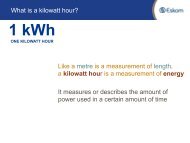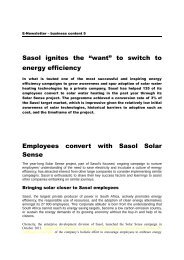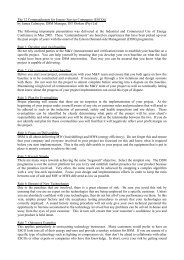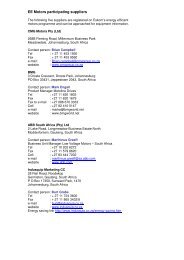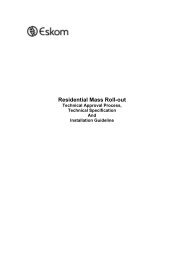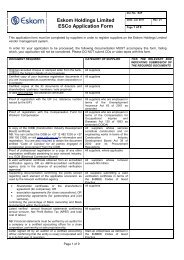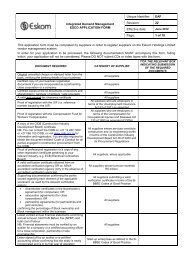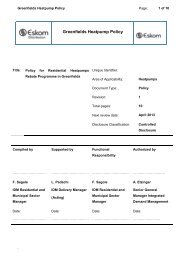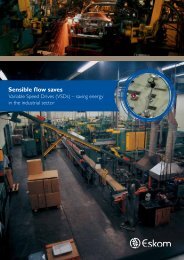You also want an ePaper? Increase the reach of your titles
YUMPU automatically turns print PDFs into web optimized ePapers that Google loves.
Blow the lid on ineffectiveenergy usageEfficiency in blowers and fans2
Contents1. Energy efficiency of electric fans and blowers 22. Optimising the efficiency of fans and blowers 23. Definitions• Fan 3• Blower 34. Fan pressure 35. Fan efficiency 36. Fan types 47. Relative merits of axial and centrifugal fans 68. Choosing the correct fan 69. Fan perfomance 610. Typical fan system problems 711. Energy management opportunities 912. Optimised fan systems: saving power, preserving equipment 1213. Energy efficiency checklist 1214. Support and advice 1315. References 13
1. Energy effi ciency of electric fans and blowersIn common with most other countries in both the developed and the developing world, South Africa needs moregeneration capacity. The extent to which <strong>Eskom</strong> is able to supply the country’s demand for electric power has a directimpact on economic growth.All sectors of the economy can reap major benefi ts from implementing energy effi ciency policies. By optimising processesand plant effi ciency, companies reduce input costs and increase their return on investment. As an added benefi t, reducedenergy consumption means reduced environmental impact, an important part of the “triple bottom line.”This information brochure aims to assist industrial and commercial users of electricity to improve the energy effi ciencyof electric fans and blowers. It explains the benefi ts of energy effi cient fans, types of fans and blowers, factors impactingfan performance, the importance of simple regular maintenance and ways to improve performance while also reducingelectricity consumption and operating costs.It concludes with a summary checklist and details of free energy effi ciency advisory services available from <strong>Eskom</strong>.2. Optimising the effi ciency of fans and blowersWidely used in various industrial applications, fans are more subject to misuse, abuse and faulty applications than virtuallyany other type of equipment. The result of ineffective usage is an unnecessary high energy cost which can be reducedto yield sizeable savings. Such savings are particularly desirable given the growing international move towards reducedenvironmental impact.3. Defi nitionsFanA fan is a device that causes the fl ow of a gaseous fl uid by creating a pressure difference on the mediumto be transported. The gaseous fl uid transported by the fan is most often air and/or toxic fumes (whereas blowersmay transport a mixture of particulates and air).BlowerA blower is similar to a fan, except that it can produce a much higher static pressure. Sometimes higher pressureis achieved by a multi-stage impeller arrangement. Engineers distinguish fans and blowers for low pressure and centrifugalcompressors for high pressure. In this brochure, blowers and fans are considered to fall under the same broad defi nition.4. Fan Pressure• Fan Total Pressure – Velocity pressure + Static Pressure.• Fan Velocity Pressure – It can be expressed as resistance to fl ow of air or as the drag resistance of the air.• Fan Static Pressure – It is a stationary pressure that can be either positive or negative and can be expressedas a bursting pressure.InletLouvresFilterHeaterChange shape(contraction)Fan outletdiffuserBalance orcontrol damperDelivery grilleIn industrial settings, fans provide the motive power to circulate air for heating or cooling. Specially designed fansor blowers in selected applications are also used for materials handling. The control of the energy consumed by fansis important to the overall effi ciency of the systems in which they operate.Air inVentilated spaceBy applying several simple principles of design and maintenance, the power consumption of fans can be optimised,enabling energy savings. Furthermore, implementing variable speed drives, at a cost, will enable the performance of fansto be adjusted to accurately meet the demands of the task at hand, providing further energy savings.AirAcceleratingFanLoss indiffuserDucting, bends, etcLoss acrossdamperAir deceleratingOutlet diffusersTurning vanes(typically used on shortradiuselbows)PressureLouvrelossFilterlossHeaterlossLoss in change ofduct tapePressure increase inthe fanLoss in ductsbends etcexit velocitylossLoss across grilleHeat exchangerFigure 2: Pressure behaviour and terminology of a typical ventilation fan installationBafflesFilterInlet vanesCentrifugal fanBelt driveMotor controllerVariable frequency driveMotor5. Fan effi ciencyIs expressed in percentage (%) and describes the ratio of the fan output power (kW) to the fan input power (kW).• Fan (motor) input power – Is the power to the motor that is required to drive the fan and may include belt drive,gear box etc.• Fan output power - Is the product of the fan pressure and the volume.• If the fan total pressure is used, then it is expressed as “Fan Total Effi ciency.” If the fan static pressure is used, thenit is expressed as “Fan Static Effi ciency.”Figure 1: Typical fan system23
6. Fan typesThere are four basic types of fans:6.1 Centrifugal fans: move air by the centrifugal force that is produced by moving the air between the rotating impellerblades, and by the inertia generated by the velocity of the air leaving the impeller. Can be direct drive or indirectly drivenby belts, gear box or friction clutch. Performance control is achieved by altering speed or adjusting variable inlet vanes.When rotating in the wrong direction, air will continue to fl ow into the eye and out through the blades. It can be eithersingle or double inlet.through 180º and deliver 85% of the normal setting in either direction. Performance control is achieved by altering speed,adjusting impeller blade pitch angle or adjusting variable inlet vanes. Performance is enhanced by installation of inlet cone,inlet or outlet guide vanes, tail fairings and diffusers. To obtain the correct airfl ow/pressure combinations for axial fl owfans, different numbers of blades can be used for the optimum design as seen in fi gure below.Centrifugal fansFan Applications Advantages DisadvantagesBackward Curved••HVAC/IndustrialClean air supply &extraction• Medium to high effi ciencies(80 – 85%)• High volume & mediumpressure• Non overloadingcharacteristics• Can’t handle dustyenvironments• Larger casings for theLFC fans12 blades (100%)9 blades (75%)8 blades (66%)Forward Curved••HVAC/IndustrialClean air supply &extraction•••••Medium/Low effi ciencies(60 – 70%)High volume & low pressureRelative small & compactcasingSilent operationAvailable in small sizes• Can’t handle dustyenvironments• High local manufacturingcosts6 blades (50%)Figure 3: Different blade designs for axial fans4 blades (33%)3 blades (25%)Radial Bladed•••Industrial/Mining/PetrochemDust extraction applicationsHigh pressure applications• Medium volume to highpressure• Robust, can resist wearagainst abrasion••••Low effi ciencies (35 – 70%)High speed operationHigh noise levelsOverloading characteristicsRadial Flow Blading•••Industrial/Mining/PetrochemDust extraction applicationsHigh pressure applications• Medium to high volumeto high pressure• Robust, can resist wearagainst abrasion•••Low/medium effi ciencies(50 – 70%)Overloading characteristicsAvailable in larger size45” and up6.3 Mixed fl ow fans:Air enters parallel to the axis of the fan andturns through an angle which may range from30º to 90º. The pressure rise is partially bydirect blade action and partially bycentrifugal action.Aerofoil Blades••Industrial/Mining/PetrochemClean air supply &extraction••High effi ciencies (85 – 90%)High volume & medium tohigh pressureNon overloadingcharacteristics•• Extremely high labour inputto manufacture• Only available in 45” and up6.2 Axial fans: move air by the change in velocity of the air passing over the impeller blades. It can be direct or indirectdrive. Tip clearance between the tip of the blade and the fan casing is typically 0,25% of the impeller diameter. Blades caneither be fl at (steel plate) or aerofoil (cast alloy). Aerofoil sections can apply greater force to the air, increasing pressureand maintaining better effi ciency over a wider range. Increasing the thickness and curvature increases stiffness, allowingoperation at higher speeds. When rotating in the backward direction, they will reverse the direction of fl ow throughthe fan and deliver 60% to 70% of the forward quantity of air. A true reversible fan will have alternate blades rotated6.4. Cross fl ow fans:Air enters the impeller at one partof the outer periphery, fl ows inwardand exits at another part of theouter periphery.Figure 4: Airfl ow pattern through mixed fl ow fansFigure 5: Airfl ow pattern through cross fl ow fans45
7. Relative merits of axial and centrifugal fans• Axial fans offer better effi ciency over a wider range of duties whereas the centrifugal fans can have a highereffi ciency, albeit over a smaller range, on a single performance curve.• The performance of a single speed axial fan can be altered simply by adjusting the impeller blade pitch angle.• The performance of a single speed centrifugal fan requires the installation of variable inlet vanes.• Axial fans generally run faster than centrifugal fans and, as a consequence, are much noisier.• Axial fan impellers are generally manufactured from aluminium in an effort to keep weight to a minimum.As a consequence the potential for erosion is greater, particularly if there is water in the shaft.• The light material used in the blades along with the high rotational speed of axial fans makes them proneto erosion and, even in good, dry conditions, it is reasonably expected that this erosion will signifi cantly reduce thefan performance within fi ve years.• Centrifugal fan impellers are fabricated from plate and are generally hollow. As a consequence, when there is waterin the shaft, the nose of the blade is prone to pitting allowing water to enter the hollow section. Suffi cient waterin this section will cause the impeller to become unbalanced and, if allowed to continue, it will result in high vibrationand eventual failure of the impeller shaft.• Centrifugal fans traditionally require the construction of large concrete foundations to the motor and ductwork.The cost of these foundations signifi cantly increases the capital cost of the fan.8. Choosing the correct fanThere are several acceptable ways to determine a fan design for a specifi c application. In the fi rst method, where theapplication requirements do not vary greatly and fan designs have a diameter approximately 1,2m or less, a standardor pre-engineered fan may be used. These fans can be selected from a supplier’s brochure.When the application involves more complex specifi cations or a larger fan, then a design based on an existing modelconfi guration will often satisfy the requirements. Many model confi gurations already cover the range of current industryprocesses. An appropriate model from the fan company’s catalogue is selected, and the company’s engineers applydesign rules to calculate the dimensions and select options and material for the desired performance, strength andoperating environment. Some applications require a dedicated, custom confi guration for a fan design to satisfy allspecifi cations.All industrial fan designs must be accurately engineered to meet performance specifi cations while maintaining structuralintegrity. For each application, there are specifi c fl ow and pressure requirements. Depending on the application, the fanmay be subject to high rotating speeds, and operating environments with corrosive chemicals or abrasive air streams, andextreme temperatures.Larger fans and higher speeds produce greater forces on the rotating structures; for safety and reliability, the design musteliminate excessive stresses and excitable resonant frequencies.9. Fan performance9.1 Fan power requirementThe work done by a fan can be measured by the quantity of air it delivers, and the pressure against which this airis delivered. The overall fan effi ciency relates to the theoretical output against the electrical power supplied to the fansystem – this includes fan losses, belt drive losses, and motor losses.Understanding the points at which losses occur provides the context in which optimisation can occur to maximise thework done by a fan while minimising energy usage.Fans operate under a predictable set of laws concerning speed, power and pressure. A change in the speed (revolutionsper minute - RPM) of any fan will predictably change the pressure rise and kilowatts necessary to operate it at the newRPM, i.e. reduction in speed is directly proportional to a cubed reduction in power.9.2 System effect factorsA fan is normally tested with open inlets with a straight duct attached to the outlet. This results in uniform airfl owinto the fan and effi cient static pressure recovery at the fan outlet. If these conditions are not matched in the actualinstallation, the performance of the fan degrades; this must be allowed for when selecting a fan.Fans are sensitive to their application in the air distribution system. This characteristic is called “system effect” andinvolves air movement at the inlet and outlet connections of the fan. The changes in direction of fl ow at the outletor inlet of the fan will adversely affect fan performance. Dampers very close to the inlet or outlet and branch ducts veryclose to the discharge will also have an adverse effect on fan performance. The biggest problem with the system effectis that it cannot be measured in the fi eld even though it reduces the output of the fan.10. Typical fan system problems10.1 Oversized fansDesign engineers tend to oversize fan requirements. This may initially be an oversized fan and, thereafter, an oversizedmotor to drive the fan. Oversizing fans is often an attempt at providing adequate impact, however, this creates operatingproblems such as expensive operating costs, noise and airfl ow problems.10.2 High operating and maintenance costsThis is generally caused by ineffi cient fan operation that can be as a result of poor fan selection, poor system design andwasteful airfl ow control practices. In order to reduce maintenance and operation costs, a fan should be kept operatingwithin a reasonable range of its best effi ciency operating point.10.3 Poor airfl ow controlFigure 6: Illustration of Fan LawsReducing RPM by 10%decreases the staticpressure by 19% and anincrease in RPMby 10% increases thestatic pressure by 21%Reducing RPM by10% decreases powerrequirement by 27% andan increase in RPM by10% increases the powerrequirement by 33%Where Q=flow, SP=Static Pressure, kW=Power and N=speed (RPM)This problem typically refers to inadequate delivery of air to various points in the system, surging operation and highlevels of noise. This may be caused by poor system balancing and leakage. Leakage can be as a result of dampers leftopen or leaks in the duct work. In the case of forward inclined and radial blade fans, it can lead to overwork and motorsoverloading. Depending on where the operating point of the backward inclined blades and axial fl ow fans on the fancurve is, it can result in an increase in power, but these two types of fans have non-overloading characteristics.kW67
11. Energy management opportunitiesPressurePressurePowerDuty pointShaft powerThe balancing of an air handling system normally requires the services of an experienced specialist and is generallyperformed after the system is installed. While fan systems are generally optimised at installation, the components of thesystem wear down over the years. Fan wheels go out of balance due to dirt accumulation, which causes vibration andnoise. Bad bearings on the fan shaft can contribute to vibration as well as cause damage to fan wheels. Dirty fi lters canreduce airfl ow considerably, reducing the motor load, and creating false savings.It is therefore evident that the fi rst step in assessing and optimising air-handling systems is to keep them at the designedoperating conditions through proper maintenance.Straight blades Curved blades QuantityFigure 7: P-Q and power curve of Forward inclined bladesRadial bladesQuantityFigure 8: P-Q and power curve of Radial bladesFigure 9: P-Q and power curve of Backward inclined bladesPressurePressurePowerDuty pointStraight blades Curved blades QuantityPressurePressurePowerDuty pointShaft powerShaft power11.1 Implementing a maintenance programmeA maintenance programme for fans should be tailored to the specifi c needs of the facility in which the fans are beingused. A suggested programme includes the following actions:• Daily: observe fan sounds, vibration, bearing temperature, and reading of installed gauges and meters.• Monthly: check drive belt alignment, belt tension, and lubricate the fan bearings.• Semi-annually: inspect fan shaft seals, check inlet and outlet dampers, inlet vanes, drain and refi ll oillubricated bearings.• Annually: check lubrication lines to assure proper movement of grease or oil, fan auxiliaries, recalibrate all associatedinstrumentation and carry out performance tests.11.2 Specifi c maintenance opportunitiesBy understanding how ineffi ciencies creep into fan systems, maintenance crews can identify better how to correctproblems, and ensure optimum performance of fan systems. Among some of the common issues that arise are lossesfrom poorly fi tted belt drives, improperly lubricated components, failing bearings, losses due to air leaks and dirty fi lters.Monitoring and addressing these issues are low-cost opportunities for energy optimisation that also ensure the longevityof the equipment.11.2.1 Belt drive lossesImproper alignment of the fan drive sheaves can cause excessive power requirements and damage to belts. Properlyaligned and tensioned belt drive systems have predictable mechanical losses; misaligned and loose belts cause additionallosses that have an impact on energy consumption. When using a direct drive where the impeller is attached to themotor shaft, losses of up to 10% can be experienced. In the case of belt driven fans, a power loss of 17–25% betweenthe pulleys and fan belts can be expected.11.2.2 Lubricating fan components according to manufacturer’s instructionsLubrication of fan components such as couplings, shaft bearings, adjustment linkage and adjustable supports must bemaintained with proper lubricants, and at intervals, as recommended by the fan manufacturer.11.2.3 Cleaning fan components regularlyFans and fi lters, particularly those handling dirty air, should be cleaned regularly to maintain their effi ciency. Contaminationon blades and the housing interior causes higher static pressure loss in the fan, thereby, reducing effi ciency.11.2.4 Correcting excess noise and vibration to ensure smooth and effi cient operationThe noise and vibration of the fan can be caused by one or more factors:10.4 Electrical system wearElectrical systems take strain when there are frequent start ups of large electrical loads. The use of soft starters for largemotors helps to extend fan motor life and keeps the motor temperature low. Variable speed drives (VSD) are also usedto soft start fans.• The fan wheel is out of balance.• The bearings are worn.• Insuffi cient isolation.• The shaft seal is misaligned.• There is corrosion between the shaft and bearing.89
11.2.5 Repairing leaksType of flow control Advantages DisadvantagesEnergy is lost when air leaks out of loose connections, improperly-sized damper shaft openings and unsealed expansionconnections. These and similar conditions at fan suctions and discharges should be corrected.11.2.6 Replacing loaded air fi lters• Pulley change: reduces the motor/drive pulley size.••Permanent speed decrease.Real energy reduction as per fan laws.• Fan must be able to handlecapacity change.• Fan must be driven by V-belt systemor motor.Loaded (dirty) air fi lters are a common cause of poor performance in fan systems. Filter manufacturers providerecommendations for the pressure drop at which their fi lters are considered fully loaded for various air velocities at theinlet to the fi lters. Filters should be replaced before their pressure drop reaches the loaded values for the particular airvelocity. Balancing a system with loaded fi lters will result in excessive air fl ow, and higher fan energy consumption whenthe fi lters are replaced.• Dampers: reduce the amount of fl owand increase the upstream pressure,which reduces fan output.••Inexpensive.Easy to install.• Provide a limited amountof adjustment.• Reduce the fl ow but not the energyconsumption.• Higher operating andmaintenance costs.11.3 Additional low cost opportunitiesSimple energy management actions present opportunities to reduce the power consumption of industrial fans at a lowcost that is quickly recouped through the reduced power bill. Typical energy management opportunities include:• Inlet guide vanes: create swirls in thefan direction thereby lessening theangle between incoming air and fanblades, and thus lowering fan load,pressure and airfl ow.• Variable pitch fans: change the anglebetween incoming airfl ow andthe blade by tilting the fan blades,thereby reducing both the motorload and airfl ow.• Improve fan effi ciency because bothfan load delivered airfl ow are reduced.• Cost effective at airfl ows between80-100% of full fl ow.• Less effi cient at airfl ows lower than80% of full fl ow.• Applicable to some axial fantypes only.• Reducing fan speed to suit optimum system air fl ow with balancing dampers in their maximum open position forbalanced air distribution.• Improving fan inlet and outlet duct connections to reduce entrance and discharge losses.• Shutting down fans when not required.11.4 Higher cost retrofi t opportunities• Can keep fan effi ciency high overa range of operating conditions.• Avoid resonance problems as normaloperating speed is maintained.• Can operate from a no-fl ow to a fullflow condition without stall problems.• Fouling problems if contaminantsaccumulate in the mechanicalactuator that controls the blades.• Operating at low loads for longperiods reduces the power factorand motor effi ciency, thus losingeffi ciency advantages and risking lowpower factor charge from the utility.Optimising fan systems is also possible through investing in more advanced modern equipment. Upgrading fans in this mannerrequires a capital investment and professional intervention including detailed analysis and implementation expertise.Typical energy management opportunities that can be achieved by retrofi tting new equipment to existing fans include:• Adding variable speed drive motors which allow fan output to follow system requirements.• Replacing outdated equipment with new units sized for optimum effi ciency.• Replacing oversized motors.• Installing a microprocessor-base energy management control system.11.5 Addressing fl ow controlAir handling systems are usually engineered for 100% design fl ow, but can in many cases operate with less fl ow - or justenough fl ow - to address the task at hand. In many cases, fans operate at 100% only despite the fact that they couldpotentially be adjusted to operate at a far lower rating. Controlling the fl ow with dampers or air inlet vanes or installinga variable speed drive can achieve optimal airfl ow.Dampers or vanes are not considered an option, since this approach wastes energy. Variable speed drives, which havethe ability to re-adjust the fan to exact needs through speed control, reduce fan noise and more importantly, save themost energy.Fans and the motors driving them are usually oversized because:• Filters clog and leaks develop.• Design engineers are conservative.• The next smaller sized fan could not meet design fl ow requirements.If preliminary investigations by specialists indicate good potential savings with the use of the adjustable speed drives,a speed control specialist should be consulted to work out the details.Fans serve over a wide range of operating conditions. These conditions vary according to ambient conditions, occupancyand or production requirements. If a fan is not appropriately sized then there are several means of controlling the fl owrate of a fan, e.g. temporarily reducing the air or gas fl ow rate. These can be applied to both centrifugal and axial fans.• Variable Speed Drive (VSD): • Most improved and effi cient • Mechanical VSDs havereducing the speed of motorfl ow control.fouling problems.of the fan to meet reduced• Allow fan speed adjustments over a • Investment costs can be a barrier.fl ow requirements.continuous range for VFDs specifi cally.• Mechanical VSDs: hydraulic clutches,• Effective and easy fl ow control.fl uid couplings, and adjustable beltsand pulleys.• Improve fan operating effi ciency overa wide range of operating conditions.• Electrical VSDs: eddy current clutches,wound rotor motor controllers, and • Can be retrofi tted to existing motors.variable frequency drives (VFDs: • No fouling problems.change motor’s rotational speed byadjusting electrical frequency • Reduce energy losses and costsof power supplied).by lowering overall system fl ow.• Multiple speed fan.• Disc throttle: a sliding throttle thatchanges the width of the impellerthat is exposed to the air stream.• Operate fans in parallel: twoor more fans in parallel insteadof one large one.• Operate fans in series: using multiplefans in a push-pull arrangement.••Effi cient control of fl ow.Suitable if only two fi xed speedsare required.••Need to jump from speed to speed.Investment costs can be a barrier.• Simple design. • Feasible in some applications only.• High effi ciencies across widevariations in system demand.• Redundancy to mitigate the riskof downtime because of failureor unexpected maintenance.• Two smaller fans are less expensiveand offer better performance thanone relatively large one.• Can be equipped with other fl owcontrols to increase fl exibility andreliability.••••Lower average duct pressure.Lower noise generation.Lower structural and electricalsupport requirements.Suited for systems with long ducts,large pressure drops across systemcomponents, or high resistances..• Should only be used when the fanscan operate in a low resistance,almost in a free delivery condition.• Not suited for low resistancesystems.1011
12. Optimised fan systems: saving power, preserving equipmentAs this brochure has made clear, improving the performance of fan systems in industrial settings can be achieved throughsimple interventions that need not incur any substantial cost to the enterprise. By optimising maintenance regimes, theenergy consumption of fan systems can be improved while an ancillary benefi t of better reliability and longevityof equipment can be achieved. For those organisations where fan systems signifi cantly contribute to energy costs,it may be necessary for professionals to evaluate the systems carefully and examine the potential viability of implementingvariable speed drives, and electronic controls of fan systems for optimisation.13. Energy effi ciency checklistGood housekeeping and regular maintenance of fans makes perfect energy sense, saving your business downtimeand money. Shown below is a summary of relatively simple actions that you can take with the fans and blowersin your business:Check1 Check and adjust drive belt alignment and tension.2 Regularly listen to fan sounds, vibrations and check for signs of wear.3 Regularly lubricate fan bearings and clean fan components.4 Regularly replace loaded air filters.5 Check for air leaks and faulty damper settings.6On an annual basis check lubrication lines, fan auxiliaries, calibrate instrumentation wherenecessary and carry out performance tests.7 Establish and follow a regular maintenance programme, and ensure staff are trained accordingly.8 When fitting new fans and blowers ensure your supplier conducts a proper needs analysis,replaces oversized motors, new units are sized at optimum efficiency and that your air handlingsystem is properly balanced by an experienced specialist.9 Whenever fitting a new fan or blower, install variable speed units when appropriate,to get your job done more efficiently.10 Use smooth, well rounded air inlet cones for fan intakes.11 Avoid poor flow distribution at the fan inlet.12 Minimise fan inlet and outlet obstructions.13 Clean screens, filters and fan blades14 Minimise fan speed.15 Use low slip or flat belts for power transmission.16 Check belt tension – monthly.17 Use variable speed drives for large variable fan loads.18 Variable speed drives in good working order.19 Use energy efficient motors for continuous or near continuous operation.20 Use energy efficient motors for continuous or near continuous operation.21 Minimise number of bends in ducts.22 Ensure that fans and blowers are turned off when not needed.23 Monthly fan maintenance:• Inspection of all components• Bearing lubrication and replacement required• Belt tightening and replacement• Motor repair or replacement• Fan cleaning24 Adopt inlet guide vanes in place of discharge damper control.25 Operate the fan near to its best operating point (BOP).26 Reduce transmission losses by using energy efficient flat belts or cogged raw-edge V-beltsinstead of conventional V-belts.27 Minimise system resistance and pressure drops by improving the duct system.Date14. Support and adviceCall the <strong>Eskom</strong> Contact Centre on: 08600 ESKOM (08600 37566) andlog a query for an energy advisor in your area to contact you. Or visitwww.eskom.co.za/dsm for information on energy effi cient technologiesand adaptations.15. References• Energy Effi ciency Guide for Industry in Asia –www.energyeffi ciencyasia.org• Bureau of Energy Effi ciency (BEE), Government of India. EnergyEffi ciency Guide Book• US Department of Energy (US DOE), Energy Effi ciency andRenewable Energy, 1989. Improving Fan System Performance– a sourcebook for industry www1.eere.energy.gov/industry/bestpractices/pdfs/fan_sourcebook.pdf• http:/en.wikipedia.org/wiki/industrialfans• SADC Industrial Energy Management Project - Module 9• Donkin Fans Training Seminar 2009• AMC Basic mine ventilationRemember, if you reduce fan speed (RPM) by just 10% you could reduce the power required by as much as 27%.1213
Issued by <strong>Eskom</strong> Demand Side Management August 2010<strong>Eskom</strong> Holdings Limited Reg No 2002/015527/061ESKD124538 DSM Fan <strong>Brochure</strong>


